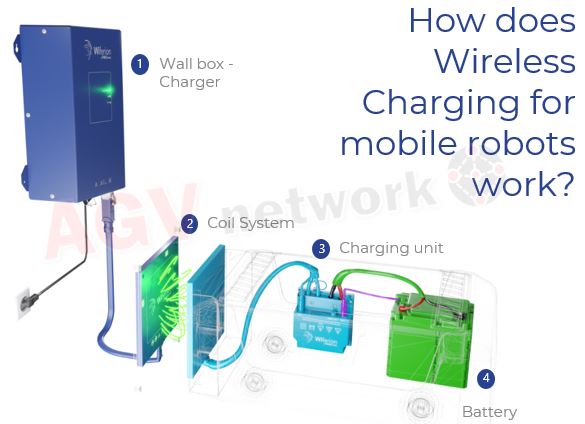8 AMR Wireless Charging Benefits: How inductive charging improves mobile robot systems
Wireless charging for Autonomous Mobile Robots is not a trend anymore. Many manufacturers are incorporating this technology into their vehicles. Why? There are several important benefits... lets's discover them. 👇🏽
What are the Advantages of Wireless Charging for AMRs?
The main advantages are:
- Remarkable Energy Utilization up to 93%- 95%.
- Instantaneous Energy Supply Upon Activation
- Zero Contact Means Zero Maintenance
- Enhanced Safety
- Superior Positioning Flexibility for AMRs
- Interoperability Across Various Types of Autonomous Mobile Robots
- Data Transfer During Charging
- Suitable for Outodoors Applications

This picture is taken from the whitepaper: Mobile Robot Batteries and Charging Systems
 My name is Alfredo Pastor ... I love to find and explain new technologies that really bring benefits to the mobile robot users... so here we are....
My name is Alfredo Pastor ... I love to find and explain new technologies that really bring benefits to the mobile robot users... so here we are....
In this article, I explain what at the main benefits of wireless charging for AMR Robots. Take your time and enjoy the show!
Brief intro to wireless charging for autonomous mobile robots
Wireless, contactless... I think you can imagine... mobile robots are able to charge batteries without contact poles between the robot and the charging station.
How's this possible? 🤔

This picture is taken from the whiteppaer: Mobile Robot Batteries and Charging Systems
We have the charger that supplies power to a stationary active fixed coil mounted on the floor or wall.
This coil generates a magnetic field that induces alternated current in a coil located in the robot... and that's it. This indiced current is used to charge the mobile robot battery.
There are several things to understand. I cannot speak about wireless charging, without commenting the different amr charging strategies as well as the different types of batteries. So, it woul dbe great if you could donwload this whitepaper filled with... tons of info. Promised!

| Click here to download the whitepaper |
These are the main benefits of Wireless Charging for autonomous robots:

Remarkable Energy Utilization up to 93%- 95%
The wireless charging system is able to convert a high percentage of the electrical power it draws into usable energy for charging the robot's batteries.
With an efficiency rate between 93% to 95%, it means that the vast majority of the electrical energy is effectively used, with very little being lost as waste or heat.
This high efficiency ensures that the energy is being used in the most productive way, leading to less electricity consumption and more cost-effective operation over time.
Such high efficiency is indicative of advanced technology in the wireless charging system, making it a superior choice for powering autonomous mobile robots.
Instantaneous Energy Supply
Unlike traditional contact charging methods that may require time to ramp up power delivery or to establish a physical connection, the wireless system is designed to eliminate any lag.
The moment the charging system is activated, it starts transmitting energy at full strength directly to the robot's batteries without delay.
This instant surge ensures that the robot can begin or resume its tasks quickly, enhancing productivity by minimizing downtime usually required for energy replenishment.
In the contact solution, we have a charging module installed in the mobile robot that must move while starting/finishing to charge.
This operation is time consuming. Maybe only few seconds, but those seconds add up over time, and time = money. 💲
Zero Contact: Zero Maintenance
The absence of physical connections in the wireless charging system leads to a reduction, or complete elimination, of maintenance efforts.
Traditional charging systems rely on physical contact points or connectors that can wear out, corrode, or require cleaning due to repeated use or exposure to environmental factors.
In the wireless solution, nothing moves. It means a simpler mechanical solution avoiding springs or linear actuators needed in the traditional contact opportunity charging.
It is not easy to define the operational cost due to the “moving parts”, but you can be sure that in the long run, maintenance cost of the whole charging system will be lower with the wireless solution.
Further, traditional contact copper electrodes tend to get dirty and create debris. Debris materials create spiked current arcs that could represent a problem for the robot electronics if not properly protected.
Enhanced Safety
Wireless charging enhances safety in the workplace by cleverly removing the physical and electrical hazards associated with traditional charging methods.
Without the need for charging poles, there's nothing to trip over, creating a clearer and safer workspace.
It also circumvents the danger of sparks or electrocution, as there are no exposed connectors that could malfunction or suffer from corrosion.
This is particularly vital in environments with flammable materials where even a small spark could have direct consequences.
Moreover, the absence of contact points means the system is more resistant to water damage, reducing the risk of short circuits and electric shocks in moist conditions.
Wider Positioning Tolerance

I love this feature because it is intimately linked to technology behind the autonomous mobile robot concept.
The contact charging poles must be in “contact”, so the AGV positioning will depend on the shape and dimension of these poles (on board and on floor or wall).
Moreover, with the contact charging poles, your Automated Guided Vehicle will probably be required to arrive to the charging station from one single direction.
This feature is very interesting for Autonomous Mobile Robots (AMR), which do not follow a given path and can vary their trajectory depending on surrounding environment.

An AGV with contact electrodes for opportunity charging is obliged to arrive from one direction

An Autonomous Mobile Robot with wireless charging mat for opportunity charging can arrive from all directions
Moreover, as explained in this article, the positioning, of AMRs SLAM Navigation, is still less accurate than other mobile robots with other navigation technologies (laser, magnetic, etc). Thus, having a charging technology that allows wider tolerance positioning is a great benefit.
Interoperability Accross Various Types of Autonomous Robots

One wireless charging system can provide different Voltages for different battery types.
This means you only need one charging system to charge different vehicles, for example an AMR with a 48 V lithium-ion battery and ... even a manual forklift with a 24 V lead-acid battery.
All vehicles can use the same charging pad and the charging system is able to autonomously choose the right power for the vehicle.
Intelligent data transfer during wireless charging

Some suppliers offer CAN connection allowing to transfer data during the charging process. All the relevant battery and vehicle data can be transferred into a cloud or directly to the AMR management system.
This feature helps to manage and monitor the AMR Robot fleet together with advanced programming of predictive maintenance in order to optimize your logistic process.
Suitable for Outdoor Autonomous Mobile Robots

Wireless charging systems are specially suitable ot for outdoor autonomous mobile robots.
They are easy to seal reaching ratings like IP65 or IP67.
The lack of physical contact in wireless charging systems significantly reduces the risk associated with water exposure and electrical short-circuits and the charging process is safely contained within a sealed unit (even IP65 or 67).
The absence of exposed conductive parts means that water cannot infiltrate and disrupt the electrical pathways, thereby preventing short-circuits.
Thus, the contactless nature of wireless charging not only makes it safer in wet conditions but also more reliable, as the risks of water-induced electrical failures are greatly minimized.
Conclusions about the benefits of wireless charging for AMR Robots
If we think about AMRs, the inductive charging technology offers a suite of additional, practical benefits that extend beyond the technology itself, largely due to the opportunities it presents for charging within the workflow.
This "In-Process-Charging" allows vehicles to top up their batteries during natural pauses in their work cycle or while queued for their next task, integrating seamlessly into existing processes without the need for infrastructural alterations. Charging stations can be unobtrusively mounted on walls or simply placed on floors, minimizing disruption in the workspace.
In other words, your AMR will not lose time running to a separated charging station.
Moreover, the overall efficiency of inductive charging means that you might find yourself requiring either a less powerful charger or benefiting from shorter charging times. This increase in operational efficiency means that AMRs spend more time active and fulfilling tasks, potentially reducing the total number of AMRs needed.
In evaluating the total operational costs, one must consider not only the cost of electricity but also the long-term savings from reduced maintenance, which often tips the scale in favor of wireless solutions over traditional contact-based systems.
Understanding that cash flow and budgeting are vital, it is crucial to approach the shift to wireless charging as a strategic investment.
I'm talking about the long-term benefits and savings.
A thorough analysis tailored to your specific context will help determine whether wireless charging aligns with your company's needs and how it could contribute to a more streamlined, cost-efficient operation.
|
Related articles How do AGV Wireless System Work? How do Automated Guided Vehicles Charge? Types of Batteries Used by AGVs AGV Price - What are the key cost drivers in an AGV System? Vehicles, Commissioning, Service. Discover them all. |
 Written by Alfredo Pastor Tella (agvnetwork editor).
Written by Alfredo Pastor Tella (agvnetwork editor).
Follow me on LinkedIn... let's create a mobile robot community to discuss and learn about these outstanding systems.



